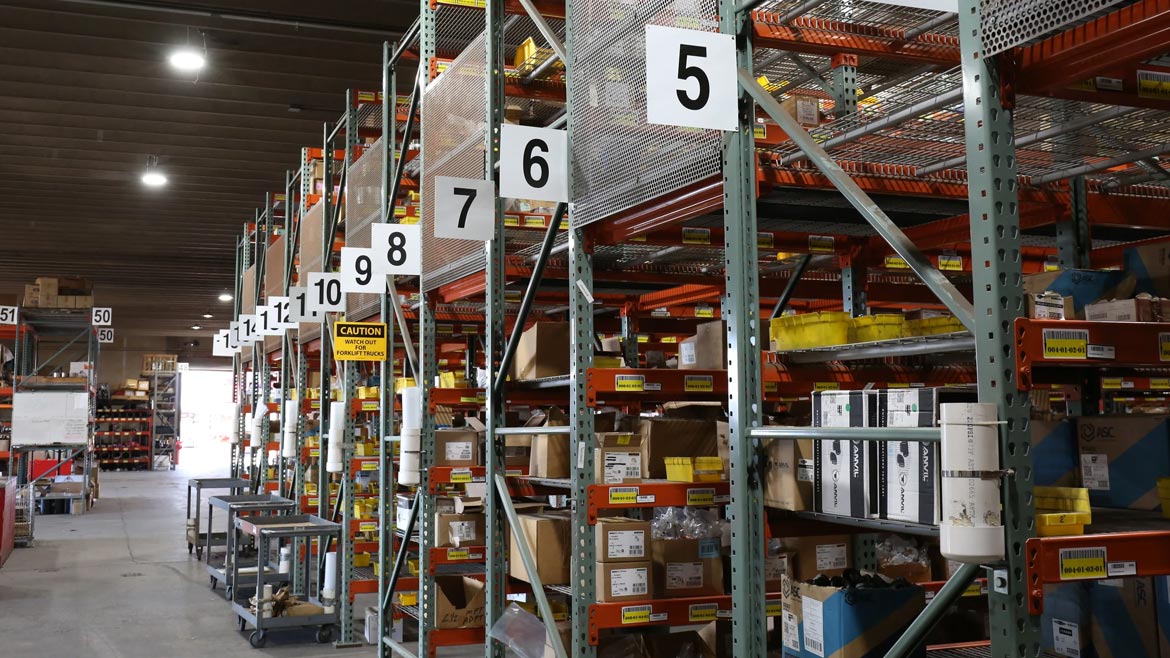State of the industrial PVF market
Politics and regulation make huge impact.

All images courtesy of Venturi Supply
The global industrial pipe market is forecasted to reach $52.6 billion by 2030 with a CAGR of 4.1% from 2024 to 2030. Market sectors such as power generation, petrochemical and industrial processes, along with the ongoing demand to replace aging pipelines and develop new municipal infrastructure, are driving factors behind a healthy demand for industrial PVF projects.
Although demand certainly isn’t lacking, industrial PVF players from across the country have been hit with regulatory changes that stall project starts, while other areas are finally benefiting from government subsidiaries.
For example, in the Eastern part of the country, Richy Milligan, Chief Sales Officer for Eastern Industrial Supplies says business has been steady due to a backlog of projects that will last through 2024 and some of 2025.
“Our area of the country has been the beneficiary of multiple multi-year projects, many of which have been funded by governmental subsidies. Since these grants and subsidies have already been dispersed and/or pledged, the majority of these projects will be completed, thus, creating a backlog of work in the region, at least through the end of 2024 and first quarter 2025,” he says. “Because of this, business has been steady to moderately busy in most areas Eastern serves in its regional footprint.”
Over on the West Coast, Tom Murphy, CEO of Ace Stainless Supply says project starts are being delayed. “The industrial market in California has been hit by increased taxes, regulations and emissions and does not show signs of slowing down. More and more industrial manufacturers have moved out of California, including fabrication facilities,” he says. “Contractors are still seeing the bids come through, but what we’re hearing is that the projects are being pushed back. With that being said, there is still opportunity for Industrial PVF and growing new industries such as lithium mining and hydrogen gas.”
Don Russell, vice president of sales for Merit Brass sums it up well, noting that some areas of the country are active while others are much quieter than normal.
“We view the market as a bit uneven as market participants attempt to interpret potential November election results along with the policy ramifications and resultant effects at home and abroad. Some geographic areas in the U.S. remain extremely active while others are currently a little quieter than usual.”
Scott Chamberlain, Venturi Supply — parent company to Ameripipe, Tri Star Industrial, BPS Supply Group and others — industrial and commercial Segment president, says the industrial market is seeing a downturn.
“The industrial PVF market is currently experiencing a downturn, particularly in California. We're noticing a significant number of projects being delayed, and some have been canceled altogether. This slowdown impacts overall demand and creates a cautious atmosphere within the industry. Despite these challenges, we continuously monitor the market to identify emerging opportunities and adjust our strategies accordingly.”
As far as projects leading the way in the industrial space, battery plants, data centers, semiconductor chips, wastewater, Department of Defense support plants and human and pet food processing plants are all areas of activity these experts note to be active today.
Election year
Just months away from a monumental election, industrial PVF pros are anticipating big changes depending on which political party wins the presidency. Increased regulations, electrification mandates and high inflation are all political factors impacting the health of the construction market.
“The continuation and potential broadening and/or increasing of the existing rates of tariffs will be a key factor, especially since the Biden administration has begun imposing new tariffs on steel, which ironically gives all of this a bipartisan feel to it,” Russell explains. “The intense focus on bringing the rate of inflation down is another key factor as is the timing by which the U.S. Fed decides to implement interest rate cuts.”


Milligan adds that issues arise when government subsidies are involved and spending is often accompanied by regulations and mandates.
“For example, there have been multiple EV (Electric Vehicle) battery plants built or being built in the southeast with government subsidies (US taxpayer dollars) involved. Certain government mandates have also accompanied these grants, including required percentages of vehicles manufactured in the United States to be electric by certain dates, thus theoretically, supporting demand for the new battery plants,” he says. “Unanticipated issues such as battery performance in extreme weather conditions, lack of a national charging station infrastructure, vehicle cost to the public, and a general lack of consumer confidence has led to less than anticipated EV sales, causing stress on battery sales demand on an investment already made.”
Milligan adds that the GOP has pledged to remove national EV mandates, reduce regulations and continue to lower taxes to stimulate the US economy from a principle of “capitalistic supply and demand” versus tax and spend.
“Eliminating or reducing regulations and lowering taxes have proven very productive as well, producing long-term, sustaining growth and employment for the country with minimal inflation,” Milligan says. “The results of this year’s election will be monumental as to the direction our country will turn.”
As always, the health of the oil and gas sector is a huge indicator of the overall health of the industrial PVF market. Murphy says the candidate that supports oil and gas is the candidate the industrial sector needs.
“Whichever president supports oil, gas and water along with less regulations is the candidate we need,” he says. “But ultimately, we’re looking for the president that puts The American People first and promotes growth, government spending and brings more manufacturing back to America.”
Top challenges
In addition to the ongoing challenges presented by increased regulation and waiting for government spending to kick in, the industrial PVF market faces hurdles related to delayed raw materials, increased shipping costs, container shortages and slow cash flow of project managers.
“Distributors today are faced with delays of raw materials and finished and semi-finished PVF products from southeast Asia,” Russell points out. “Additionally, due to vessel and container shortages, ocean freight costs have increased quite dramatically recently. Taking everything into consideration, there will most likely be pressure on industry fill rates across a multitude of product lines as the shipping lead time delays and increased shipping costs were not figured into pipeline purchases until recently.”
Milligan agrees, adding that managing inventories from the standpoint of direct imports/indents versus higher cost/less risk purchases from master distributors has been a challenge.
Chamberlain adds that high borrowing costs and supply chain disruptions are still concerns for industrial distributors. “The Federal Reserve's interest rate hikes contribute to higher borrowing costs, making financing operations and capital investments more expensive. Distributors also grapple with supply chain disruptions and the need to adapt to rapidly changing market conditions. These factors require a proactive and flexible approach to navigate effectively.”
Once again, the impending election results could present some trials for the industrial market. “Depending on election results, tariffs could come into play with regard to certain countries hostile to the United States,” Milligan says.
Chamberlain agrees, adding that the election could significantly impact commodity metals. “The upcoming election is critical, as it could significantly impact the commodity metals market, particularly if tariffs are reinstated. These tariffs could help boost HRC pricing, which has been under pressure. The direction of trade policies and economic strategies adopted post-election will be crucial in shaping the market dynamics. We're also monitoring overall economic policies, including infrastructure spending and regulatory changes, which could stimulate or hinder industrial growth.”
To no surprise, filling open positions continues to plague the industrial PVF market. “Continued staffing issues have affected all regions of the US, as qualified, interested candidates for the PVF and commercial plumbing distribution industry have become more difficult to recruit and hire,” Milligan says. “Healthcare and general benefits have also continued to rise, causing stress to the bottom-line and a burden to company ownership as well as employee endured costs.”


When speaking to relevant challenges for the industrial market, Murphy notes that California is “its own beast” when it comes to regulations and the EPA, and says the consolidation of master distributors has been an interesting discussion over the past couple years.
Staying on top of commodity pricing is a vital task – and challenge – for any industrial distributor. Some pros say they aren’t too concerned with commodity pricing today, while others note a few areas to keep an eye on.
“We’re not too concerned at this time with commodity pricing, we believe we bought at the best time we could without overspending and locking up too many of our resources, Murphy explains. “Carbon steel pipe, fittings and flanges have been the most noticeably concerning; You have to sell your inventory fast, numbers coming in are considerably lower then what most suppliers bought at.”
Contrarily, Chamberlain says he is quite concerned with the steel market right now. “We are highly concerned about commodity pricing, particularly in the steel market. HRC prices have dropped by 40% since the start of 2024, which has substantial implications for our top-line revenue and inventory value,” he says. “Since steel pipe accounts for 30% of our gross revenue, such a decline can significantly impact our financial performance. We are actively exploring ways to mitigate these impacts, including optimizing our supply chain and adjusting our inventory management strategies.”
Russell again points out that oil is the ultimate commodity. “Oil price movement and supply and demand dynamics are crucial to virtually all other commodities. Copper typically leads base metals, so we expect that prices of nickel will remain relatively elevated. The anticipated interest rate cuts should also result in higher commodity pricing.”
Milligan says monitoring commodity pricing is part of the daily routine at Eastern Industrial Supplies. “Strategically minded distributors are always engaged with commodity pricing. This is part of our daily review, studying raw material, scrap markets, as well as collaborating with our manufacturers and master distributors for trends and changes. Copper, petroleum, iron, carbon, chrome and nickel are always included in the forefront of our review.”
Optimism for 2025
It’s always a difficult task to forecast the future, and particularly so during a vital election year. But overall, these industrial PVF players remain optimistic for the health of the market moving forward.
“2024 is going to be flat and we will get our share of the marketplace,” Murphy says. “There is still an invaluable need for a service and quality driven independent PVF supplier. Ace Stainless Supply has made tremendous investments this year that will secure our need and relevance in the marketplace. The strong will survive and thrive; we’ve learned so much and continue to adjust to the marketplace.”
Chamberlain agrees, saying Venturi is preparing for various scenarios and focusing on maintaining operational efficiency and customer satisfaction to weather potential market fluctuations.
“The industrial market will remain relatively flat and potentially down by 7%, depending on the outcomes of the upcoming election. The election's impact on economic policies and investor confidence will be crucial in determining market trends,” he says. “Despite the challenges, there are aspects of the market that are exciting. The ongoing technological advancements in sectors like semiconductors, EVs, and data centers present significant opportunities for growth. Additionally, the push towards sustainability and renewable energy projects drives innovation and creates new market segments. While the overall market is challenging, these emerging trends offer avenues for strategic investments and long-term growth.
Russell says that although the outcome of the election leaves much to the unknown, Merit Brass is excited to move forward post-election and focus on the growth of the company and the PVF market.
“We’re excited by the expectation that following the election season, much of the political histrionics should go by the wayside and a relative sense of normalcy and collaborative focus on growth will return,” he says. “We at Merit Brass are very optimistic and enthusiastic about the prospects for growth in the PVF market in 2025 and beyond.”
Milligan is optimistic as a backlog of work, at least for the southeastern region, and new projects should sustain business through the end of 2024 and first quarter 2025, and he notes continuous gratitude and excitement for the opportunity to work in the industrial PVF space.
“When you are not excited to participate in the PVF and commercial plumbing market each morning, it’s time to reevaluate one’s profession. What better opportunity do we have to engage with folks from all walks of life, while honoring God in all that we do by caring for people, continuously improving, and growing profitably? This business is not really about pipe, valves and fittings; it’s about making a positive impact on people’s lives today, tomorrow and for generations to follow.”
Looking for a reprint of this article?
From high-res PDFs to custom plaques, order your copy today!






